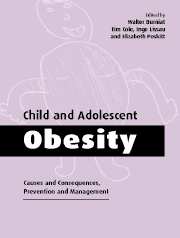Book contents
- Frontmatter
- Contents
- List of contributors
- Foreword
- Preface
- Part I Causes
- Part II Consequences
- 7 Clinical features, adverse effects and outcome
- 8 The obese adolescent
- 9 Prader–Willi and other syndromes
- 10 Hormonal and metabolic changes
- 11 Risk of cardiovascular complications
- Part III Prevention and management
- Index
11 - Risk of cardiovascular complications
Published online by Cambridge University Press: 02 November 2009
- Frontmatter
- Contents
- List of contributors
- Foreword
- Preface
- Part I Causes
- Part II Consequences
- 7 Clinical features, adverse effects and outcome
- 8 The obese adolescent
- 9 Prader–Willi and other syndromes
- 10 Hormonal and metabolic changes
- 11 Risk of cardiovascular complications
- Part III Prevention and management
- Index
Summary
Introduction
The prevalence of obesity among children and adults has increased over the last few decades (Kuczmarski et al., 1994; Troiano et al., 1995; Freedman et al., 1997), and the obese are at increased risk of diabetes, coronary heart disease, hypertension and certain cancers (Kushner, 1993; Hodge & Simmet, 1994; Baumgartner et al., 1995). Because substantial weight loss is difficult to maintain (Dyer, 1994), several studies have focused on the development of overweight and its consequences.
As with adults, numerous studies have found that obese children tend to have adverse levels of lipids, blood pressure, insulin and other risk factors for coronary heart disease (CHD) (Berenson et al., 1993). Furthermore, obesity in early life is associated with the early stages of atherosclerosis, including fatty streaks and raised lesions (Berenson et al., 1998), and coronary calcification (Mahoney et al., 1996). It is also likely that obesity in early life influences the subsequent risk for various diseases in adulthood, and there is some evidence that this association exists independent of adult weight (Must et al., 1992). The secular trend in overweight among youths (Troiano et al., 1995; Freedman et al., 1997) suggests a possible increase in the incidence of CHD and other diseases (Pinhas-Hamiel et al., 1996) among adults.
The current chapter reviews the associations between obesity and CHD risk factors in early life, and the evidence suggesting that child-onset obesity influences subsequent clinical disease.
- Type
- Chapter
- Information
- Child and Adolescent ObesityCauses and Consequences, Prevention and Management, pp. 221 - 240Publisher: Cambridge University PressPrint publication year: 2002
- 7
- Cited by



